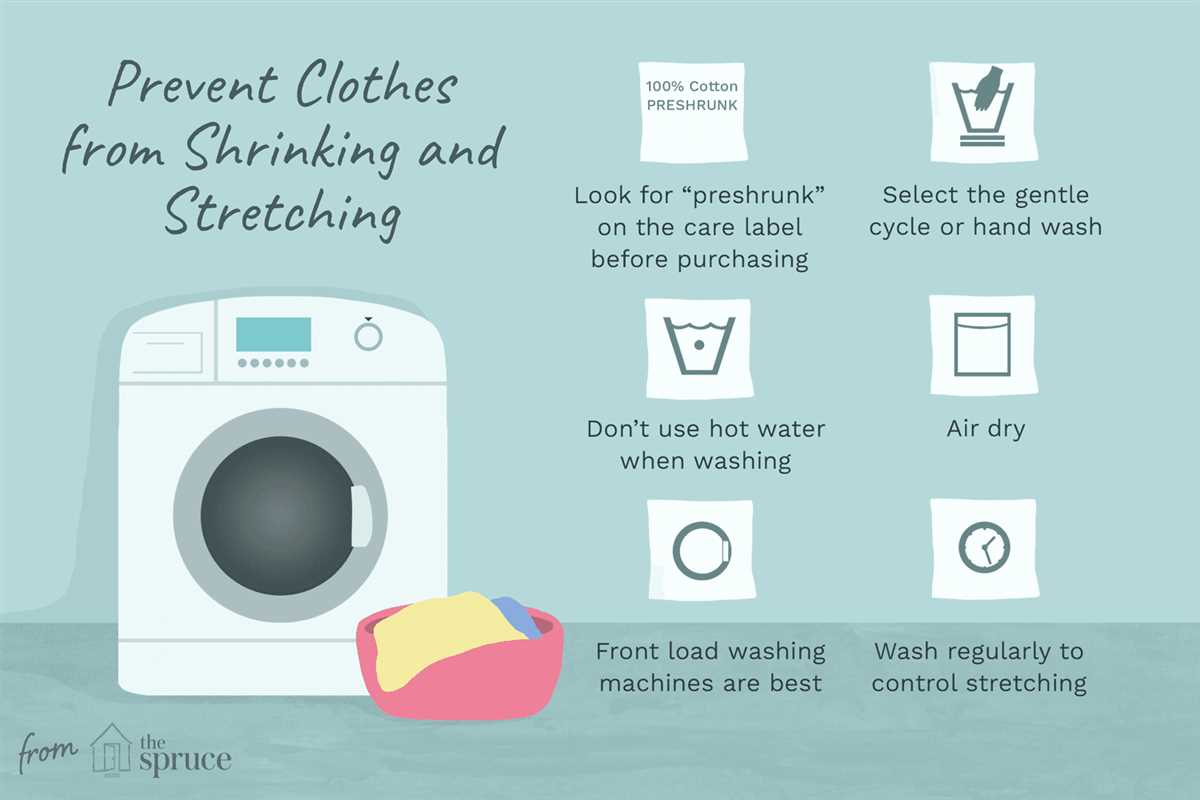




Many people worry about putting their clothes in the dryer, fearing that they will come out smaller than they were before. This is a common concern, especially when it comes to delicate fabrics like wool or silk. However, the truth is that tumble drying doesn’t necessarily shrink clothes.
So, why do clothes sometimes shrink in the dryer?
When clothes are exposed to heat and agitation, the fibers that make up the fabric can contract, causing the garment to shrink. This is why it’s important to follow the care instructions on the clothing label, as not all fabrics can withstand the high temperatures and intense tumbling of a dryer.
There are a few ways to minimize the risk of shrinkage when tumble drying:
1. Use a low heat setting: Opt for a gentle or low-heat cycle on your dryer to reduce the chances of shrinking your clothes. The lower the heat, the less likely it is that the fibers will contract.
Top RatedEfficient Heated Clothes Airer for Fast DryingEnvironmentally friendly with low energy useThe STATUS Heated Clothes Airer quickly dries your laundry while being energy efficient and environmentally conscious. Its durable aluminium build ensures longevity, and it can handle a hefty 15kg load with ease.2. Use a drying rack: If you’re concerned about shrinkage, consider air drying your clothes instead. Hanging them on a drying rack can help them maintain their shape and size.
3. Don’t overfill the dryer: Overpacking the dryer can cause clothes to become compressed, increasing the likelihood of shrinkage. To give your clothes room to move, only fill the dryer about halfway full.
By following these simple tips, you can help protect your clothes from unnecessary shrinkage and ensure that they last longer. Understanding how tumble drying affects different fabrics is key to keeping your wardrobe in great shape.
Does Tumble Drying Shrink Clothes?

Tumble drying is a convenient method of drying clothes, but many people wonder if it can cause their clothes to shrink. The answer is not always straightforward, as it depends on several factors.
Material
The material of the clothing is a primary factor in determining whether it will shrink in the dryer. Natural fibers such as cotton, wool, and linen have a higher likelihood of shrinking compared to synthetic materials like polyester and acrylic. This is because natural fibers tend to tighten and contract when exposed to heat, causing the clothing to shrink.
Temperature

The temperature at which you dry your clothes also plays a significant role. Higher temperatures can cause the fibers to shrink more dramatically. If you are concerned about shrinkage, it is best to opt for a lower heat setting or even air-dry your clothes.
Size and Fit
If your clothes are already tight or snug-fitting, they may be more likely to shrink in the dryer. This is because the fibers have less room to contract and may cause the clothing to become even tighter. If you want to avoid shrinkage, it’s advisable to avoid drying clothes that are already too tight.
How to Minimize Shrinkage

If you want to minimize the risk of shrinkage when tumble drying your clothes, there are several steps you can take:
- Read the care label: Always check the care label on your clothes for any specific instructions regarding tumble drying.
- Use low heat: Opt for a lower heat setting on your dryer to minimize the risk of shrinkage.
- Remove while slightly damp: Take your clothes out of the dryer while they are still slightly damp and finish drying them on a clothesline or flat surface.
- Reshape while damp: If your clothes have already shrunk, you can try reshaping them while they are still damp to stretch them back to their original size.
Overall, tumble drying can cause clothes to shrink, especially if they are made of natural fibers and subjected to high heat. To minimize this risk, it’s important to consider the material, temperature, and fit of your clothes, and take proper care when drying them.
The Process of Tumble Drying
Tumble drying is a common method of drying clothes using a machine called a tumble dryer. This machine works by rotating the clothes at a high speed while blowing hot air through them. The process involves several steps:
- Loading the dryer: Before starting the tumble drying process, you need to load the clothes into the dryer. Make sure not to overload the machine as this can prevent the clothes from drying properly.
- Selecting the settings: Once the clothes are loaded, you need to select the appropriate settings for the type of fabric and desired dryness level. Most dryers have different heat settings and drying options to choose from.
- Tumbling and heating: Once the settings are selected, the tumble dryer starts rotating the clothes in a drum while heating the air inside. The hot air is circulated through the drum, evaporating moisture from the clothes.
- Cooling down: After the clothes have dried to the desired level, the tumble dryer goes through a cool-down phase. During this phase, cool air is blown through the drum to lower the temperature and prevent the clothes from wrinkling.
- Removing the clothes: Once the cooling down phase is complete, you can remove the clothes from the tumble dryer. It is important to remove them promptly to prevent them from becoming wrinkled.
Tumble drying is a convenient way to quickly dry clothes, especially during rainy or cold seasons when air-drying may not be feasible. However, it is important to follow the manufacturer’s instructions and select the appropriate settings to avoid damaging or shrinking the clothes. Additionally, some fabrics are not suitable for tumble drying and may require alternative drying methods.
Factors That Contribute to Shrinkage

There are several factors that contribute to the shrinkage of clothes during the tumble drying process:
- Fabric Type: Different fabrics have different shrinkage tendencies. Natural fibers such as cotton, wool, and linen are more prone to shrinkage, while synthetic fibers like polyester and nylon are less likely to shrink.
- Weave or Knit: The weave or knit pattern of the fabric can also affect its shrinkage. A tight weave or knit is more resistant to shrinkage compared to a loose weave or knit.
- Initial Fit: Clothes that are already tight or snugly fit may experience more shrinkage during drying compared to clothes that have a looser fit. This is because the fabric is forced to shrink in order to retain its shape.
- Heat and Drying Time: Higher heat and longer drying times can increase the chances of shrinkage. Exposing clothes to excessive heat and prolonged drying times can cause the fibers to contract and shrink.
- Washing Method: The way clothes are washed prior to drying can also contribute to shrinkage. For example, using hot water, harsh detergents, or agitating the clothes vigorously can weaken the fibers and make them more prone to shrinkage during drying.
- Garment Construction: Certain garment construction techniques, such as poorly sewn seams or hems, can lead to shrinkage when exposed to heat during drying. The weak points in the garment are more likely to shrink and distort.
It is important to take these factors into consideration when tumble drying clothes to minimize shrinkage. Reading the care labels on garments and following the manufacturer’s instructions can also help prevent excessive shrinkage.
How to Prevent Shrinkage in the Tumble Dryer

While tumble drying can be convenient and time-saving, it can also lead to shrinkage of your clothes if not done properly. Here are some tips to help prevent shrinkage in the tumble dryer:
- Read the care labels: Before tossing your clothes into the dryer, always check the care labels for specific instructions. Some fabrics are not suitable for tumble drying and can shrink easily. Follow the recommended drying settings mentioned on the label.
- Use the right heat setting: If you have the option to adjust the heat setting on your dryer, choose a lower or delicate setting. High heat can cause shrinkage in certain fabrics. Avoid using high heat, especially for delicate items like wool or silk.
- Remove clothes while slightly damp: It’s best to remove your clothes from the dryer while they are slightly damp instead of completely dry. Overdrying can lead to more shrinkage. You can always air dry them or hang them to finish drying naturally.
- Avoid overcrowding the dryer: Ensure that there is enough space in the dryer for the clothes to move around freely. Overcrowding can cause friction and lead to shrinkage. It’s better to dry your clothes in smaller loads to prevent this.
- Invest in mesh laundry bags: If you’re worried about specific items shrinking, consider using mesh laundry bags. These bags help protect delicate fabrics and prevent them from getting tangled with other clothes, reducing the risk of shrinkage.
- Use dryer balls: Dryer balls are a great addition to your laundry routine. These reusable balls help to create space between your clothes, allowing air to circulate more efficiently. This can reduce drying time and minimize shrinkage.
- Consider air drying: If you want to avoid shrinkage altogether, air drying is the safest option. Hang or lay your clothes flat on a drying rack or clothesline. This method may take longer, but it will help preserve the shape and size of your garments.
By following these tips, you can minimize the risk of shrinkage in the tumble dryer and keep your clothes looking their best. Remember to always check the care labels and adjust your drying settings accordingly.
Taking Care of Delicate Fabrics
Delicate fabrics require special attention to ensure they remain in good condition after each wash. Here are some tips for taking care of delicate fabrics:
1. Sorting
When sorting your laundry, separate delicate fabrics from heavier and rougher fabrics to prevent potential damage. This helps reduce friction during the washing and drying processes, which can cause tears or pilling.
2. Hand wash or gentle cycle

For delicate fabrics, it’s recommended to either hand wash them or use the gentle cycle on your washing machine. This helps minimize agitation and reduces the risk of stretching or tearing the fabric.
3. Use a mesh laundry bag
When machine washing delicate fabrics, place them in a mesh laundry bag to provide an extra layer of protection. This helps prevent them from getting tangled or snagged on other clothes or the machine itself.
4. Use mild detergent
Opt for a mild detergent specifically designed for delicate fabrics. Avoid using harsh detergents that contain enzymes or bleaching agents, as they can cause damage or discoloration.
5. Choose the right water temperature

Check the care label on your delicate fabrics to determine the recommended water temperature. In general, it’s best to use cool or lukewarm water to prevent shrinkage or color fading.
6. Avoid excessive agitation
During the washing process, minimize agitation by reducing the spin cycle speed or using the delicate cycle setting. High-speed spinning can cause delicate fabrics to stretch or become misshapen.
7. Air dry or low heat
After washing, avoid tumble drying delicate fabrics if possible. Instead, gently squeeze out excess water and lay the items flat on a clean towel to air dry. If using a dryer, use the lowest heat setting and remove the items when they are still slightly damp to prevent over-drying.
8. Iron with care

If ironing is necessary, use a low heat setting and place a pressing cloth or a clean cotton cloth between the iron and the fabric to prevent direct contact. Avoid applying too much pressure, as this can damage delicate fabrics.
Following these tips will help ensure that your delicate fabrics remain in good condition and last longer, allowing you to enjoy their beauty and softness for years to come.
Expert Tips for Safe Tumble Drying
Tumble drying can be a convenient way to dry your clothes quickly, but it’s important to follow some expert tips to ensure the safety of your garments:
- Read the Label: Before tumble drying any article of clothing, always read the care label. It will provide specific instructions on whether the item can be tumble dried or if it requires air drying.
- Sort Clothes: Separate your clothes based on fabric type, thickness, and weight. This will help prevent uneven drying and potential damage to delicate garments.
- Pre-Treat Stains: Treat any stains on your clothes before placing them in the tumble dryer. The high heat from the dryer can set stains, making them more difficult to remove later.
- Remove Excess Moisture: Before starting the tumble dryer, make sure to remove any excess moisture from the clothes by either squeezing them or spinning them in the washing machine. This will help reduce drying time and energy usage.
- Don’t Overload: Avoid overloading the dryer, as this can prevent effective drying and may lead to wrinkling and tangling of clothes. Leave enough space for the clothes to move around freely.
- Use the Right Settings: Set the tumble dryer to the appropriate heat and time settings based on the fabric type. Delicate fabrics, such as silk and wool, require lower heat settings, while heavier fabrics can tolerate higher heat.
- Check Regularly: Periodically check the clothes during the drying process to ensure they are drying evenly and not getting overheated. This will help prevent shrinkage and damage.
- Clean the Lint Filter: Clean the lint filter before each use to improve airflow and drying efficiency. A clogged filter can lead to longer drying times and increased risk of fire.
- Air Dry Delicates: For delicate or valuable items, it’s best to air dry them instead of using a tumble dryer. This will minimize the risk of shrinkage, stretching, or damage.
By following these expert tips, you can safely tumble dry your clothes and prolong their lifespan while minimizing the risk of shrinkage or damage.
FAQ
Will tumble drying shrink my clothes?
Yes, tumble drying can shrink clothes, especially if they are made from natural fibers like cotton or wool.
Which fabrics are more prone to shrinking in the dryer?
Fabrics like cotton, wool, and linen are more likely to shrink in the dryer compared to synthetic fabrics like polyester or nylon.
How does tumble drying cause clothes to shrink?
Tumble drying applies heat and agitation to the clothes, which can cause the fibers to contract and result in shrinkage.
Can I prevent my clothes from shrinking in the dryer?
Yes, you can prevent clothes from shrinking in the dryer by following the care instructions on the garment’s label, using lower heat settings, or opting for air drying.
What should I do if my clothes have already shrunk in the dryer?
If your clothes have already shrunk in the dryer, you can try stretching them while they are damp or reshaping them while they are still wet. Alternatively, you may need to accept the shrinkage and adjust the way you wear or care for the garment.
Does tumble drying shrink clothes?
Yes, tumble drying can shrink clothes. The heat from the dryer can cause the fibers in the fabric to contract, resulting in shrinkage.














